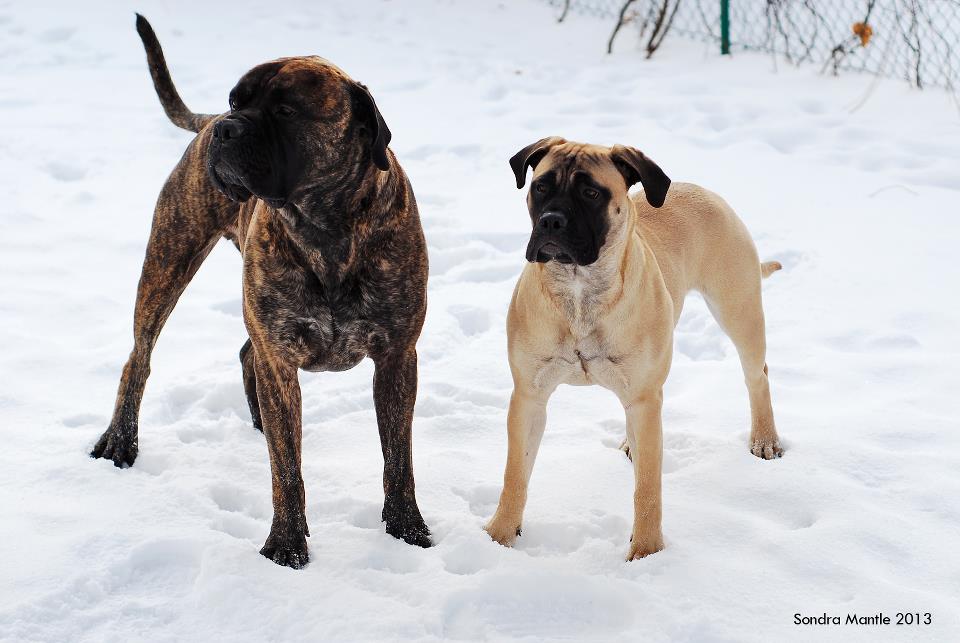Help, My Dog Is Limping!
Courtesy of: Ashley
In a previous blog I shared with you one thing that scared me about owning a Bullmastiff: Bloat! This is the second thing that gives me a fright: Cruciate Ligament Rupture.
Ligaments are bands of tissue that connect bones to each other. Cruciate ligaments (CLs) live in the knee joint. These ligaments connect the femur (thigh bone) and tibia (shin bone). These ligaments help the knee move backwards and forwards.
CL damage can occur when the knee twists in an unnatural direction. Often times, a CL tear can occur when a dog is running, then stops to change direction. The direction change twists the knee in a manner that the knee is not supposed to bend. When the CL tears it causes pain and the dog becomes lame. In most cases the dog is not weight bearing (limping) or will only toe-touch and the knee may appear swollen. The dog may begin to use the leg again but will become lame again with time.
Monitoring your dog’s exercise routine can help reduce the risk of a CL rupture. Larger or overweight dogs are more prone to this condition. Making sure your dog is at an ideal weight and keeping larger breeds in a controlled exercise routine will help control the wear and tear on their joints. Small breed dogs with a luxating patella (when the knee cap moves out of place) may be predisposed to rupturing a CL.
A veterinarian looks for “drawer” when diagnosing a ruptured CL. By placing one hand on the femur and one on the tibia and manipulating the joint they can observe abnormal movement.
Within a healthy knee there is very little movement in the joint but with a ruptured CL there is laxity in the joint and movement occurs. With large or nervous dogs assessing for “drawer” can be difficult to accomplish. In these cases heavy sedation may be needed to allow the veterinarian to manipulate the joint. A veterinarian may want radiographs (X-rays) of the joint to see if there is arthritis present as well. A radiograph can help to confirm the diagnosis of CL rupture.
There are different ways to treat a ruptured CL. Factors that influence the choice of treatment are the size of the dog, if the rupture was a complete or partial tear, and the dog’s home environment. If the CL was completely ruptured, surgery is recommended.
One surgical method to correct the rupture is called “extracapsular repair.” In this method, a strong suture material (cruciate line) is used to create an artificial ligament.
The torn ligament is completely removed and the cruciate line is placed from the outside lower portion of the femur to the inside upper portion of the tibia, which acts like a brace within the knee. After this surgery the dog must have very strict rest for 8 to 12 weeks. The dog’s activity is restricted, with only activities such as leash walking and (eventually) swimming permitted. The veterinarian will guide the owner with appropriate activities for the dog as the healing progresses. During the healing time the instructions given by the veterinarian should be followed precisely to prevent further injury. This method of surgery is performed here at Truro Vet.
Another surgery commonly performed is called Tibial Plateau Leveling Osteotomy (TPLO). This surgery is recommended for dogs weighing more than 50 pounds or in dogs with poor conformation (ie: Bulldog). The purpose of this surgery is to correct the angle of the tibia in relation to the femur, to stop the femur from being able to move in an abnormal direction. The veterinarian cuts a portion of the tibia and rotates it before reconnecting it with plates and screws.
This surgery is more challenging to carry out but usually generates a faster return to normal function. TPLO surgeries are referred by our veterinarians to specialists in this type of procedure.
In select cases, medical treatment may be chosen in lieu of surgery. Circumstances include: the CL is only partially torn; the dog has other health conditions; the dog’s age or other health conditions present a risk for anesthesia; or the owners cannot keep the dog quiet for the 8 to 12 week healing period. The veterinarian will discuss restricting the dog’s exercise to activities like leash walking or swimming. If the dog is overweight, weight loss and low calorie diets will be discussed. Frequently anti-inflammatory medications are used to reduce pain and inflammation. Products containing glucosamine and other joint health supplements may be added to the dog’s diet.
If a CL rupture is not treated, severe joint deterioration usually occurs. Arthritis sets in and the dog will usually compensate by putting more weight on the other leg causing that ligament to deteriorate and possibly tear. Without treatment you also run the risk of the dog experiencing chronic pain.
If you would like more information on risk factors for CL ruptures or you are worried your pet may be experiencing this condition, please contact the office at (902) 893-2341.






